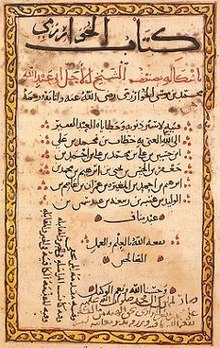Hisab al-Jabr wa-l-muqabala
al-Kitāb al-muḫtaṣar fī ḥisāb al-ǧabr wa-ʾl-muqābala ( Arabic الكتاب المختصر في حساب الجبر والمقابلة 'The concise book on the calculation methods by supplementing and balancing') or Ḥisāb al-ǧabr wa-ʾl-muqābala or Kitāb al-ǧabr wa-ʾl-muqābala is a mathematics book that was published around 825 by the mathematician Muhammad ibn Musa al -Chwarizmi was written. The word algebra goes back to the Latin translation of the title ( Ludus algebrae almucgrabalaeque ).
Historical meaning
This book is an important basic text in classical algebra, the science of solving equations . For centuries it shaped the character of algebra as a practical science without any axiomatic foundation.
The work is a good example of the importance of Islamic culture at the height of Islamic expansion , as it was practiced in the House of Wisdom in Baghdad and had a lasting influence on the history of mathematics . Numerous Islamic scholars collected the mathematical knowledge of the ancient Greeks and created a synthesis with Indian mathematics , in particular from Aryabhata and Brahmagupta . This book, too, formed a bridge between antiquity , western and Indian cultures. It had a greater influence than the work of Diophant , although it offered less content and as a pure word algebra dispensed with formulas. Al-Chwarizmi relied mainly on Brahmagupta, but probably also knew the corresponding Greek work.
The climax of medieval algebra, written in Arabic, was only reached with Omar Chajjam's Algebra On the Evidence for the Problems of al-ǧabr and al-muqabalah (" Solving Cubic Equations Using Conic Sections "), but it became the standard work for treatment of linear and quadratic equations became the book of Al-Khwarizmis among the Persians, Arabs and also later in medieval Europe .
content
According to the author, the book contains everything that “is extremely useful in arithmetic, what people need in matters of inheritance, problems of division, legal disputes, in trade, and generally in all mutual relationships; or also with land surveying, digging canals, with geometrical calculations and various other things ”.
The book is divided into 3 parts:
- Systematic treatment and resolution of the equations of the first and second degree (main part of the book) with final exercises
- Practical surveying tasks
- Solution of inheritance problems
No symbols are used in the equations, they are always expressed verbally. All equations are reduced to 6 standard types (a, b, c are non-negative coefficients; only positive solutions are considered):
Each type of equation is solved according to a rule that is geometrically proven.
The author also gives the operations that can be used to reduce problems to one of his 6 standard forms:
- al-ǧabr ("complete", "restore", "make whole") - elimination of negative expressions
- al-muqabala ("equalization") - summary of the expressions equal power per side
and the four basic operations +, -, *, /.
Although the method presented was cumbersome, it could solve all of the quadratic equations that occur in practice .
Lore
The work has been preserved in an Arabic copy and in several Latin translations.
The six types of equations have been at the heart of algebra for centuries. Only Michael Stifel allowed negative coefficients in 1544 and was thus able to reduce the number of equation types. And also only around this time (around the middle of the 16th century) was it possible to solve cubic equations in Europe (cf. Gerolamo Cardano's Ars magna sive de regulis algebraicis , Nicolo Tartaglia , Scipione del Ferro ).
literature
- Muhammad ibn Musa al-Chuwarazmi, Louis Charles Karpinski (ed.): Robert of Chester's Latin translation of the Algebra of al-Khowarizmi. With an introduction, critical notes and an English version. Macmillan, New York / London 1915 (University of Michigan Studies, Humanistic Series, XI.1), online at archive.org
See also
swell
- ↑ Helmuth Gericke : Mathematics in antiquity and the Orient. 9th edition. Marix Verlag, 2005, ISBN 3-937715-71-1 , pp. 197-199, doi : 10.1007 / 978-3-642-68630-6






